November 11, 2016
Air Date: November 11, 2016
FULL SHOW
SEGMENTS

The Trump Shade of Green
/ Peter DykstraView the page for this story
Campaign promises made prior to Donald Trump’s election as the 45th President of the United States suggest he will try to reverse a number of Obama administration environmental policies including the Clean Power Plan and U.S. commitments under the Paris climate Agreement. Peter Dykstra and host Steve Curwood discuss President-elect Trump's possible Cabinet picks and the regulatory rollbacks and policy shifts the next four years may bring. (07:25)

Green Ballot Measures
/ Jaime KaiserView the page for this story
Among the environmental ballot measures on November 8 was a carbon tax in Washington state, and an electric utility-friendly solar energy provision in Florida, that both went down to defeat. Proposals for new parks fared better in Alabama and Missouri, and a plastic bag ban was upheld in California. Living on Earth’s Jaime Kaiser examines the issues and has the story. (06:00)

New Report Shows Steep Wildlife Decline
View the page for this story
This year’s Living Planet report from the World Wildlife Fund documents nearly a 60% decline in wildlife populations since the 1970’s and warns that two thirds could be gone by the year 2020. Living On Earth Host Steve Curwood discussed the implications with WWF scientist Colby Loucks. (06:15)

Science Note: Rats Against Poachers
/ Aidan ConnellyView the page for this story
African pouched rats can grow to a yard long, and have a very acute sense of smell. So the US Fish and Wildlife Service is devoting research funds to study whether they can sniff out trafficked animal products and timber. (01:45)

DNA Tech for Rhino Protection
/ Bobby BascombView the page for this story
With rhinos on the verge of extinction, conservationists are turning to novel efforts to prevent poaching. Living on Earth’s Bobby Bascomb reports on how a DNA database in South Africa is helping law enforcement agents identify the origins of seized rhino horn in order to deter poaching. (07:10)
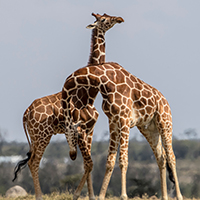
Mark Seth Lender: Giraffe Brotherly Love
/ Mark Seth LenderView the page for this story
Giraffe usually communicate silently, using visual or tactile cues. Resident Explorer Mark Seth Lender visited the plains of Kenya and observed one such conversation, between a young Giraffe and his brother. (03:00)

The Well-Tempered City
View the page for this story
For affordable housing developer Jonathan Rose, J.S. Bach’s keyboard piece, the Well-Tempered Clavier is a source of inspiration. He thinks this carefully crafted, beautiful music offers a kind of model for how to best plan a city. His new book, The Well-Tempered City creates a vision for urban life in the 21st century which he discusses with host Steve Curwood, using case studies from flourishing cities around the world. (15:30)
Show Credits and Funders
Show Transcript
HOST: Steve Curwood
GUESTS: Peter Dykstra, Colby Loucks, Jonathan Rose
REPORTERS: Jaime Kaiser, Bobby Bascomb, Aidan Connelly, Mark Seth Lender
[THEME]
CURWOOD: From Public Radio International, this is Living on Earth.
[THEME]
CURWOOD: I'm Steve Curwood. The election fallout includes a failed bid to create a carbon tax in Washington state, defeated in part by environmental justice champions.
SOLDANA: Incrementalism is not going to keep carbon in the ground. We need to take a strong stand, we need to take the leadership of communities of color, of immigrants, of people that are actually facing the pollution and facing the impacts of climate change right now because if it works for them, it will work for all of us.
CURWOOD: Also, there are only 25,000 rhinos left in the world, and they are falling fast to illegal hunting.
SOEKOE: We’ve had two rhinos poached on our concession this year, both of them right behind us over here, where the poachings took place right next to each other. The one was successful, they did get the horn, and the other one we kind of distracted them a bit earlier, so they weren’t succesful in getting the horn, but unfortunately killing the rhino.
CURWOOD: Now DNA science is giving them a fighting chance. That and more this week, on Living on Earth. Stick around.
[NEWSBREAK MUSIC: Boards Of Canada “Zoetrope” from “In A Beautiful Place Out In The Country” (Warp Records 2000)]
[THEME]
The Trump Shade of Green

President-elect Donald J. Trump (Photo: Gage Skidmore, Flickr CC BY-SA 2.0)
CURWOOD: From the Jennifer and Ted Stanley Studios at the University of Massachusetts Boston and PRI, this is Living on Earth. I’m Steve Curwood. From January, Republicans will hold both branches of Congress and the White House, which suggests a vastly different outlook for issues related to the environment, global warming and energy. Peter Dykstra of DailyClimate.org and Environmental Health News, that’s EHN.org, is here to help consider the implications of America’s new political landscape. Hi there, Peter.
DYKSTRA: Hi, Steve. Let’s start out by stating the obvious: This Presidential campaign provided the starkest contrast and deepest divide we’ve ever seen on environmental issues.
CURWOOD: Yeah, and now that we know the outcome, what can we expect?
DYKSTRA: Based on the people President-elect Donald Trump may appoint and the promises he’s made on the campaign trail, advocates of clean energy and strong environmental protection have almost nothing to cheer about.
CURWOOD: OK, well let’s run through some of those promises.
DYKSTRA: For the most part, Trump’s rhetoric has been very hostile toward environmental regulation. At one point he vowed to abolish the EPA, but in September, he said that he’ll...these are his words: “refocus the EPA on its core mission of ensuring clean air, and clean, safe drinking water for all Americans.”
CURWOOD: So clean air, clean water, those are both things that we need. What about clean power, as in the form of the Clean Power Plan?

Hillary Clinton at a rally in the battleground state of Arizona on November 2nd, 2016. Just a week later, Donald Trump clinched the eleven electoral votes from the state. (Photo: Gage Skidmore, Flickr CC BY-SA 2.0)
DYKSTRA: Not a chance. In another September promise, Trump said he’d do away with the Clean Power Plan and cut back on controversial elements of the Clean Water Act as well. He’s vowed to reverse Obama’s rejection of the Keystone XL pipeline, open up more Federal lands to fossil fuel production, and in his words, “rip up” the Paris Climate Agreement.
CURWOOD: But wait, it’s not clear that he can just cancel the Paris accord.
DYKSTRA: But I believe him when he says that he’ll try, and flipping the US from climate leadership to climate denial will impact the entire world both politically and physically. As David Roberts, who follows this issue very closely for the Vox website wrote, “Any hope of avoiding serious impact from climate change pretty much disappeared on Election Day.”
CURWOOD: And what about President-elect Trump’s statements on coal?
DYKSTRA: Well he’s said some things that even Bob Murray, the most zealous of the coal magnates, has said are unrealistic about bringing back coal mining jobs for “a thousand years.” Some coal company stocks that have plummeted in recent years picked up right after Election Day, but two market-driven phenomena that the new Administration probably can’t stop are the further decline of coal and the stunning growth of wind and solar, though clean energy leadership seems pretty much out of the question in a Trump Administration. On the campaign trail, Trump said he’s in favor of all forms of energy, but he’s also been on something of a vendetta against wind power - years of litigation against an offshore wind farm project near his Scottish golf resort.
CURWOOD: Which, by the way, the wind farm eventually won.
DYKSTRA: Correct, and he incorrectly said that US wind farms kill a million birds a year. That’s double the highest estimate from any reliable study.

President-elect Donald Trump has vowed to cancel the Clean Power Plan and the U.S. role in the Paris Agreement. (Photo: Walter, Flickr CC BY 2.0)
CURWOOD: OK, well...Now let’s stick our toes into speculative waters. Who can we expect to see carrying out the President-elect’s vision. Who are some of the names out there for a Trump cabinet?
DYKSTRA: Here are some names floated right after Election Day. For Secretary of State, the names include former House Speaker Newt Gingrich and Bob Corker, Chair of the Senate Foreign Relations Committee.
CURWOOD: Now, they would succeed John Kerry, who’s been very active in pursuing the Paris climate agreement and in establishing a huge marine reserve in the Ross Sea off Antarctica. What about Attorney General?
DYKSTRA: The nation’s leading law enforcement officer could be Rudy Giuliani, the former New York Mayor and a vocal Trump supporter. Other possibilities include New Jersey Governor Chris Christie and Florida Attorney General Pam Bondi, but both of them have been dealing with their own scandals this year. Defense Secretary is also key, given the Pentagon’s stance that climate change is a global security issue. Alabama Senator Jeff Sessions is one name out there, and in the past he’s declared that he’s “offended” by the opinions of climate scientists, and he charged EPA Administrator Gina McCarthy with what he called “stunning ignorance” on the issue.
CURWOOD: Now, what about the other cabinet posts that are more directly focused on energy and environment?

President Obama set aside Mojave Trails National Monument in California earlier this year. During his eight-year tenure, Obama has designated 23 National Monuments under the Antiquities Act, more than any other President, and could use the remaining days of his presidency to add to this legacy. (Photo: Bob Wick / BLM, Flickr CC BY 2.0)
DYKSTRA: Lew Eisenberg, the Republican National Committee finance chair, is churning in the rumor mill to be the next Secretary of Commerce. And of course, NOAA, one of the most important science and environment agencies, would be under his control. Other names floated for Commerce include billionaire investor Wilbur Ross and two former governors and Presidential hopefuls, Mike Huckabee and Rick Perry.
CURWOOD: Now what about the Department of Interior, in charge of most of the rest of public lands, wildlife protection, and more?
DYKSTRA: One of the names out there is Forrest Lucas. The other is former Vice Presidential candidate Sarah Palin. Then there’s also fracking baron Harold Hamm, and venture capitalist Robert Grady. Those two are said to be on the short list for both Interior Secretary and Energy Secretary.
CURWOOD: So, who might get the top EPA job?
DYKSTRA: The list so far includes two state officials, one appointed by Chris Christie in New Jersey, the other appointed by Vice President-elect Mike Pence when he was Governor of Indiana. Leslie Rutledge, the Arkansas Attorney General who’s helped lead the multi-state challenge to EPA’s Clean Power Plan; Robert Grady again – his name is actually up for three different cabinet posts - and Myron Ebell, a Washington lobbyist who is among the highest-profile opponents of climate change action.
CURWOOD: And let’s go down ballot, to what’s worth noting in the House and Senate.
DYKSTRA: The Democrats had hoped to win control of the Senate. That didn’t happen, Republicans still hold the majority and will control all of the committee chairmanships. Same for the House, though the Democrats harbored no illusions about taking control there. There are two noteworthy, climate-related races in Florida and Texas, though. Charlie Crist is a former Republican and former Governor of Florida. He switched parties, became vocal about climate change, and lost a 2010 Senate bid to Marco Rubio.

Venture capitalist Robert Grady is rumored to be a possible pick for three different Trump Cabinet positions, including the Secretaries of Interior and Energy, and EPA Administrator. (Photo: Opine Needles Blog, Wikimedia Commons public domain)
CURWOOD: Who also got re-elected last Tuesday, by the way.
DYKSTRA: Right. Crist made a political comeback by beating Congressman Dave Jolly, one of the few Republicans in office raising climate change concerns at all. And in Texas, Lamar Smith, chair of the House Science Committee, won re-election fairly easily, but there’s a catch. Two years ago, the Democrats couldn’t even field a candidate to oppose him. But this year, a political newcomer named Tom Wakely put a little scare into Lamar Smith and one of the key issues he raised was what some have called the persecution of climate scientists via subpoenas from the House Science Committee. Lamar Smith also threatened to jail Kathryn Sullivan, the head of NOAA. His seat is safe, but the Democrats went from zero percent last election to 36 percent this time.
CURWOOD: Now, President Obama is now a lame duck, with a hostile Congress. What do you expect from him in his final two months in office?
DYKSTRA: Well, President Bill Clinton issued 22 lame-duck executive orders, President George W. Bush issued 11. President Obama could establish new National Monuments, restrict some logging or fossil fuel extraction on public land. But the new President could likely freeze or undo any such rule.
The Bush Administration used “midnight regulations” – last minute changes that don’t require Congressional approval – to undermine the Endangered Species Act. And Bill Clinton finalized the Roadless Rule, which banned new roadbuilding on nearly 60 million acres of roadless National Forest land. And he did that with eight days to go in his term.
With all of the jubiliation among Trump supporters and the shock that’s overwhelming Trump opponents, one thing you’re not hearing right now from anyone is, “Make America Green Again.”
CURWOOD: Thanks, Peter. Peter Dykstra is with Environmental Health News – that’s EHN.org and DailyClimate.org. Talk to you again real soon, Peter.
DYKSTRA: OK, Steve, thanks a lot, talk to you soon.
Related links:
- Washington Examiner: “Trump backs off plan to eliminate EPA”
- David Roberts Vox column
- SNL Financial: Bob Murray on Trump and Coal
- Fact Check.org: Trump has claimed U.S Windpower kills “more than 1 million birds a year”
- Fox News: Lt. Gen. Mike Flynn
- Tampa Bay Times: Charlie Crist beats incumbent Dave Jolly in Florida race for U.S. House
- Washington Post: Climate change and Lamar Smith’s campaign
- ProPublica: President George W. Bush’s “Midnight Regs” that weakened the Endangered Species Act
- USDA: Bill Clinton's Roadless Rule
[MUSIC: Jake Shimabukuro et aI, “Every Breath You Take” http://www.veojam.com/watch/1426402059]
Green Ballot Measures

I-732 was defeated in Washington state, and would have resulted in the nation’s first carbon tax legislation. (Photo: Carbon Washington)
CURWOOD: With the Republican sweep of the White House and Congress one has to look to the states and localities for political diversity, as some local ballot measures showed. All of the states where Secretary Clinton won also passed recreational marijuana. And it’s now legal in eight states. And three states President–elect Trump won also approved medicinal marijuana, which will now become available in a total of 28 states. But as Living on Earth’s Jaime Kaiser reports, those weren’t the only green referenda.
KAISER: Republicans now control Congress and the presidency, and robust federal action to advance environmental issues seems unlikely, yet for green activists, the results of some state ballot measures brought a degree of solace. The most fiercely debated environmental measure was Washington State’s Initiative 732. This carbon tax plan, proposed by a group called Carbon Washington, was narrowly rejected. Some campaigners saw it as a promising opportunity to curb emissions, but not all climate activists did.
SALDAÑA: Carbon Washington, as a solution, and was one that actually was not a solution at all for Washington. And so what this does is it gives us momentum to say that yes, action needs to be done.
KAISER: Rebecca Saldaña is the executive director of Puget Sound Sage, one of the partner organizations in the alliance for jobs and clean energy that actively fought Carbon Washington’s proposal. She objected to measure 732 because it was “revenue-neutral”, meaning the money generated would offset tax cuts in other areas. Saldaña wants a different kind of carbon tax, one that funnels the cash into public social projects.
SALDAÑA: For a lot of our communities without strategic investments – all they’re getting is the tax but they’re not getting a way to participate in actually electrifying their vehicles, you know, having alternative choices, you know, that’s why people voted no.
KAISER: The Alliance plans to bring their alternative carbon plan to the state legislature in January. But Yoram Bauman, the economist behind Carbon Washington, also plans to move forward in spite of his initiative’s recent defeat.

Florida rejected Amendment 1, a solar power regulatory measure that was widely criticized throughout the state as deceptive. (Photo: tai viinikka, Flickr CC BY-NC-ND 2.0)
BAUMAN: Carbon Washington is going to continue to push for, you know, smart, bipartisan budget-friendly climate policy. We’re certainly going to participate in discussions in the legislature, and we’ll see what happens down the road.
KAISER: Similar tensions to those brewing between free-market advocates and groups on the environmental left surfaced – less dramatically -- in Rhode Island over Question 6, where voters overwhelmingly approved Green Bonds for environment and recreation.
Meanwhile in the Sunshine state of Florida, renewable energy advocates are celebrating the failure of Amendment 1, a solar energy measure put forward by a coalition of utility companies called Consumers for Smart Solar. The group Floridians for Solar Choice led opposition to the Amendment. They claimed that the measure’s confusing ballot language masked an agenda to preserve utility monopolies and undermine the solar industry and its customers. Here’s Steven Smith, a board member for Floridians for Solar Choice.
SMITH: We were able to use their deceptive language effectively against them because they were saying in Amendment 1 that they were offering the right to own and lease solar, and they were going to put that in the state constitution. Well you already have the right to own and lease solar equipment in the state of Florida. It doesn’t need to go into the state constitution. Are you gonna put the right to own a car, the right to own a refrigerator, the right to own a flashlight? I mean, it’s kind of ridiculous. You don’t need to put that into the state constitution.
KAISER: Amendment 1 saw support early on and had a well-funded campaign operation, but ultimately it wasn’t enough.
SMITH: How we were able to defeat Amendment 1 is that we have been building this broad coalition – And it’s not a paper tiger – It’s not a superficial relationship that we have with the Tea Party and the Libertarians. We are actually working very closely with them, progressives, conservatives. A broad coalition has been working now for almost two full years. So we’ve had a steady set of organizing targets that we’ve been able to work with, and our coalition has gotten stronger every step of the way.
KAISER: Californians voted on two Propositions related to a ban on single-use plastic bags. These were proposed by an alliance of plastic companies and other interest groups known as the American Progressive Bag Alliance. Proposition 65 would have directed revenue generated from fees on recyclable, compostable and reusable bags to a wildlife conservation fund but did not pass. Proposition 67 to preserve the statewide ban that went into effect last year did pass, but only narrowly, 52 to 48 percent, as Phil Rozenski, of the Bag Alliance pointed out.

The California ban on single-use plastic bags in grocery stores and other retailers remains in place in light of a “Yes” vote on Proposition 67. (Photo: Day Donaldson, Flickr CC BY 2.0)
ROZENSKI: That one actually barely passed, and it shows that even in California it’s difficult for this to have much support. Most of the support came from the Los Angeles and San Francisco Bay area, and the rest of the state appeared to be generally opposed to it.
KAISER: Bag bans are not a new phenomenon in California. Over 150 California towns and cities already have bans, and this has resulted in more than an 85% reduction in single use bags in some places. In other states, some down-ballot measures focused on outdoor project funds and animal rights. Voters overwhelmingly approved state infrastructure funding with landslide wins on park-related measures in Alabama and Missouri. As for animals rights, a win and a loss. Massachusetts voted to prohibit certain restrictive containment practices for farm animals, but in Montana a measure which would have prohibited the use of snares and traps for wild animals on state property was voted down.
For Living on Earth, I’m Jaime Kaiser.
Related links:
- Washington’s Initiative 732 on the carbon tax
- Florida’s solar ballot initiative, Amendment 1
- California’s Proposition 67, the Plastic Bag Ban Veto Referendum
- California’s Proposition 65, which would have dedicated revenue from the plastic bag ban ban
- Our interview about Washington’s carbon tax fight
[MUSIC: Golddmine1969 (Kanayama Ryohei), “Good Day, Sunshine,” not commercially available, Lennon and McCartney, available at https://www.youtube.com/watch?v=I9OvPdaIAjU
CURWOOD: Coming up...how giraffes can sing...sort of. Stay tuned to Living on Earth.
ANNOUNCER: Support for Living on Earth comes from the Gordon and Betty Moore Foundation, and from a friend of Sailors for the Sea, working with boaters to restore ocean health.
[CUTAWAY MUSIC: Celso Fonseca, “Por acaso pela tarde,” on The Now Sound Of Brazil 2, Ziriguiboom]
New Report Shows Steep Wildlife Decline

The index states that freshwater species will bear the brunt of forces that reduce population globally. (Photo: Cloudtail the Snow Leopard, Flickr CC BY 2.0)
CURWOOD: It’s Living on Earth, I’m Steve Curwood. The World Wildlife Fund and the Zoological Society of London release a Living Planet report every two years or so that assesses how the natural world is coping with the stress of rising human population. It’s a grim trend. This year they report global wildlife populations have already declined by almost 60 percent since the 1970s, and the losses continue. Colby Loucks is the senior director of the Wildlife Conservation Program for WWF, and he joins us now to explain. Welcome to Living on Earth.
LOUCKS: Thank you.
CURWOOD: So, in brief, tell me what are the findings of this Living Planet report?
LOUCKS: The big findings are that we've seen a 58 percent overall decline in the population sizes from 1970 to 2012. So, what that is, is if in 1970 you looked out your window and saw 100 of your favorite species out your window, today you would only see about 42. So, in a single population there's a 58 percent decline, but that's averaged across over 3,700 vertebrate species.
CURWOOD: So, in other words I look outside the window now where I used to see 100 crows and they are noisy, and now I'm just seeing 42. And then in my pond where there used to be 100 frogs, now there are way less than 42.
LOUCKS: Yes, that's a good point, and the fresh water loss is tremendous, and so in your pond if you saw 100 frogs, now you might only see 19.
CURWOOD: Wow. So what was the data your analysts used to put this report together?
LOUCKS: Well, most of the data comes from published scientific literature. There's many many researchers around the world and research organizations that are monitoring their own individual populations, so it's basically collecting all that information and putting it into the analysis.
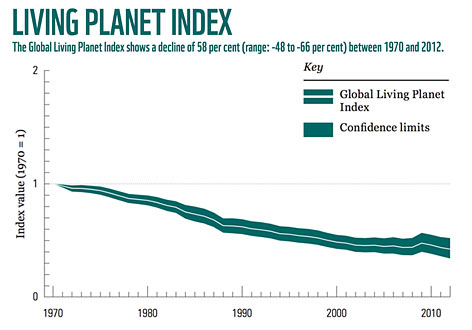
The Living Planet Index charts a steep decline in biodiversity in the late half of the 20th Century. (Photo: World Wildlife Fund)
CURWOOD: What are the factors that are driving these rapid losses in wildlife?
LOUCKS: Well, the overall, major, number-one driver is just the habitat loss. In the simplest terms you could think of a forest being converted to a farm. Also, for a lot of the wildlife, the number-two driver of loss is overexploitation, which is fancy word for saying, just taking too many out of them. So, on the terrestrial side of things, that is going to be poaching. In the marine areas, it's usually overfishing. And then, if you add maybe three more of the big drivers, it’s going to be pollution, especially bad for freshwater, and then invasive species and then finally climate change. So, there's sort of like the five Horsemen of the Apocalypse for populations that are in decline.
CURWOOD: Talk to me about what species are crashing the fastest?
LOUCKS: The biggest loss of wildlife is certainly going to be in the fresh water. So, the fresh water species have lost, on average, 81 percent of their size between 1970 and 2012 so they are driving a lot of the loss. And so you can imagine fresh water, 0.8 percent of our land surface is fresh water, but we need it for so many things. We need it for drinking water, we need it for agriculture, we use it to create dams to generate hydroelectricity, and all of that affects the fresh water biodiversity. So, we have a lot of these river dolphins, these big dolphins that are in rivers that need a lot of space, need a lot of fish, need to migrate and they're really affected by the pollution, the destruction of the rivers, and so I would say the fresh water biodiversity is really taking it on the chin.
CURWOOD: Now, talk to me about the regions of the world that you think will most likely have the biggest species loss.
LOUCKS: Well, it's interesting. Historically a lot of the species loss may have come from the areas of the temperate zones, so North America, Europe and Russia, where there's just a lot more people over hundreds of years, thousands of years. And so that's certainly in place, but that's also the regions where we've started seeing some rebounds in some of the wild cats that are in parts of Europe. On one hand, we have that kind of a dynamic going on. On the other hand, you have a lot of the tropical areas that are being converted from forest, tropical forest, to agriculture, or some of those rivers are finding new dams. So, those are probably the areas where we're going to see increases in declines. Also the tropics just have more species in them than the temperate forests.
CURWOOD: So, at this rate of decline...You know, I'm trying to do some math here…How wrong am I? It looks like this research would indicate we would just be out of wildlife by the middle of the century.
LOUCKS: Population sizes are getting smaller, but they're not necessarily going extinct locally. So, the fancy word for that is "extirpated". So, there's still going to be wildlife, but what there are, you're just seeing smaller numbers of those same populations, but the populations will still be there.
CURWOOD: So some has been critical of the metrics of your study, say it oversimplifies a very complex problem. From your perspective where does the value and the merit of this report’s data lie?
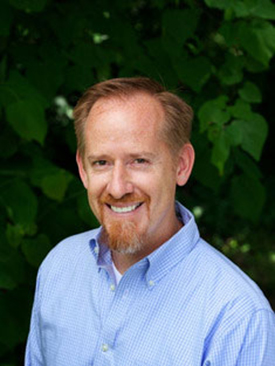
Colby Loucks directs the Wildlife Conservation program at the World Wildlife Fund. (Photo: Colby Loucks)
LOUCKS: It is a challenge. So, what we have is a single number, 58 percent decline in populations, and so the challenge is to try to portray this information that can be digestible, and I think it's not too different from other major numbers that we hear about such as gross domestic product, right? So the GDP...GDP is the economic output of a country, and most people can understand that ranges from Apple to your local florist in the basement of our building here. They're very different, but they also have this economic output. Same with the Living Planet Index. So, we have elephants in Kenya to salamanders in West Virginia, and so it's trying to capture and give you a taste in the sense of what is happening.
CURWOOD: Colby, you sound all very calm telling us this story, but it sounds pretty scary to me.
LOUCKS: [LAUGHS] Yeah, you have to have a bit of optimism in this field and you have to take a lot of negative news, but you have to find the positive places where you can succeed, and, yeah, there's a lot of areas for improvement individually to governments.
CURWOOD: Colby Loucks is the Director of the Wildlife Conservation Program for the World Wildlife Fund. Thanks so much for taking the time with us today.
LOUCKS: Thank you. It's been an absolute pleasure
Related links:
- The 2016 Living Planet Report
- Bushmeat hunting a major driver in biodiversity decline
- Colby Loucks profile
[MUSIC: Celso Fonseca, “Por acaso pela tarde,” on The Now Sound Of Brazil 2, Ziriguiboom]
CURWOOD: Coming up...how rhino DNA could help save the species and fight poachers, but first this note on emerging science from Aidan Connelly.
Science Note: Rats Against Poachers
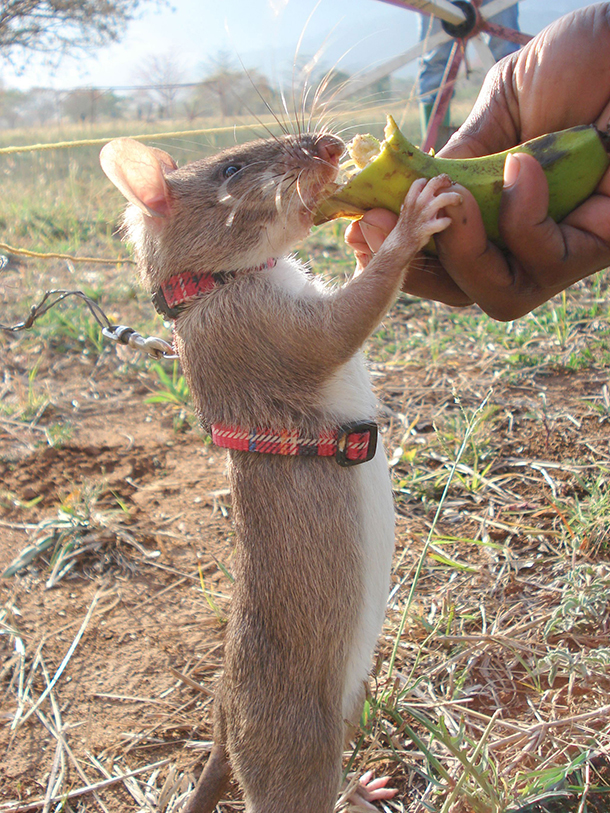
A landmine-detecting rat enjoys the spoils of labor (Photo: Gooutside, Wikimedia Commons CC BY 2.0)
[SCIENCE NOTE THEME]
CONNELLY: The African pouched rat isn’t quite like the rodents you see scurrying along subway tracks, or hanging around your local dumpster. These rats are nearly three feet long– including their 18-inch tails. And their size, along with their acute sense of smell, makes them almost more like dogs.
It’s because of that sense of smell that the US Fish and Wildlife Service has pledged one hundred thousand dollars into studying these rats, in hopes of using them to sniff out timber and wildlife trafficking in Tanzania.
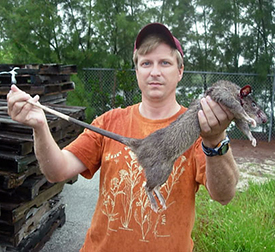
An African Pouched Rat in Florida, with human for scale (Photos: FWS, Wikimedia CC BY 2.0)
Tanzania already has a history of using African pouched rats – specifically their noses – for a number of purposes. They’ve been used to diagnose tuberculosis, as well as to detect landmines, where they’re suited up with harnesses, and fed bananas when they do a good job. Now, these oversized rats are on a new mission: Searching out wildlife crime, specifically trafficked Pangolins, the most widely poached animals in the world.
The Research funds from US Fish and Wildlife will help test the rat’s effectiveness, and, if experiments work, will help set up a program to deploy them directly to the front line, at Tanzania’s ports. If they prove effective, the African pouched rats could become invaluable to anti-trafficking groups not just in Tanzania, but around the world.
And that could be promising news for everybody: Humans, pangolins, and the three-pound, banana-munching rats themselves.
That’s this week’s note on emerging science, I’m Aidan Connelly.
[SCIENCE NOTE THEME]
Related links:
- NYTimes Op-Ed Columnist Nicholas Kristof: “The Giant Rats That Save Lives”
- The USFWS plan to combat Pangolin trafficking with African pouched rats
DNA Tech for Rhino Protection
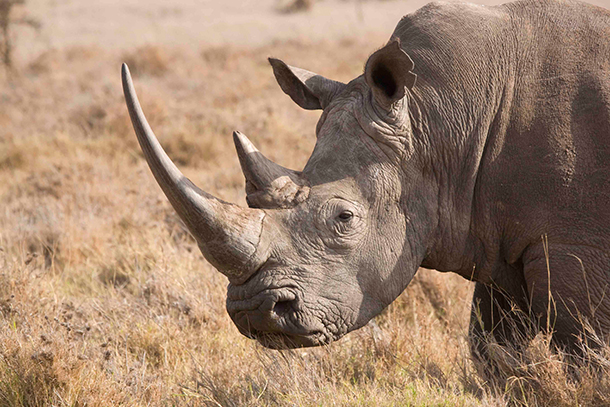
White rhino (Photo: gmacfadyen, Flickr CC BY-NC-ND 2.0)
CURWOOD: Some of the most threatened animals on the planet live in Africa, and none face more dire threats than rhinos. It seems a rhinoceros is killed every day or so, as poachers go after their horns, which are lucrative commodities in the Asian traditional medicine trade. With just 25,000 or so rhinos left in in the world the threat of extinction looms large. But now an international database that keeps track of 75 percent of them is offering some hope. This database is housed in South Africa, and from Pretoria, Living on Earth’s Bobby Bascomb reports on what it does, and how it may help save this iconic animal.
[TRUCK DRIVING]
BASCOMB: Brittle yellow grass gently blows in the wind at the black rhino game reserve near Pilanesburg National Park in South Africa. Mathew Soekoe is a field guide here. Driving a safari truck he scans the familiar landscape and points towards a nearby fence.
SOEKOE: We’ve had two rhinos poached on our concession this year, both of them right behind us over here, where the poachings took place right next to each other. The one was successful, they did get the horn, and the other one, we kind of distracted them a bit earlier, so they weren’t successful in getting the horn, but unfortunately killing the rhino.

Amy Clark, a laboratory technician at the Veterinary Genetics Lab at the University of Pretoria. (Photo: Bobby Bascomb)
BASCOMB: Stories like that are extremely common here. So common that South African law requires that a tissue sample must be collected any time a rhino is moved from one park to another or receives medical care. The sample is used to create a DNA profile for each animal that can be recorded and, in case the animal is ever poached, can be matched to confiscated rhino horn.
[FREEZER DOOR CLOSES AND A SAMPLE BAG IS OPENED]
CLARK: What I’m going to be doing is I’m opening a routine kit from a live rhinoceros that has been collected in the field.
BASCOMB: Amy Clark is a laboratory technician at the Veterinary Genetics Lab at the University of Pretoria. She opens a plastic bag to examine small tubes holding rhino skin, hair, and blood. She pulls out a piece of paper with information about this specific rhino.
CLARK: We know from this particular animal that it is from a male white rhino. It is from Limpopo province, in South Africa. And this was from a live rhino.
[WALKING AND DOOR OPENS]
BASCOMB: Clark carries the samples down a hall to the sample preparation room where technicians pound rhino horn to a powder or cut off a small piece of tissue to examine. Then they add the samples to a solution and heat it.
CLARK: The heat causes the cells to break open and release the DNA. And from there we take that solution to a machine that uses magnetic beads to pull the DNA out of solution, so we can get a good quality DNA profile.
BASCOMB: The veterinary lab has a forensic analysis for roughly 18,000 rhinos. That’s nearly three quarters of the total population, and they hope to eventually register every rhino in the world. The rhino registry helps officials prosecute poaching crimes. Dr. Cindy Harper is the director of the lab. She says criminals in possession of illegal material like rhino horn might get a slap on the wrist, but when they’re linked back to a dead rhino - a crime scene - they’ll get a much harsher punishment.
HARPER: We’re looking at cases where poachers get 29 years and more because they are actually involved in an illegal hunt and not just possession of rhino horn.
BASCOMB: The sentence for poaching can vary greatly depending on the country where the poacher was caught. Rhino poaching is a well-organized, highly profitable crime, run by a heavily armed international syndicate. Harper says her DNA database allows officers to keep tabs on how poachers are operating.
HARPER: If you look at it internationally that gives you some idea of the traceability of where that horn had moved from the carcass to its final destination and how quickly it moved.
BASCOMB: It’s connecting the dots like that, between crime scene, transit, and consumer, that Jorge Rios says is so critical. Rios is the chief of the global program to combat wildlife and forest crime at the UN office of drugs and crime. He says training prosecutors in the countries where rhino horns end up is the next step.
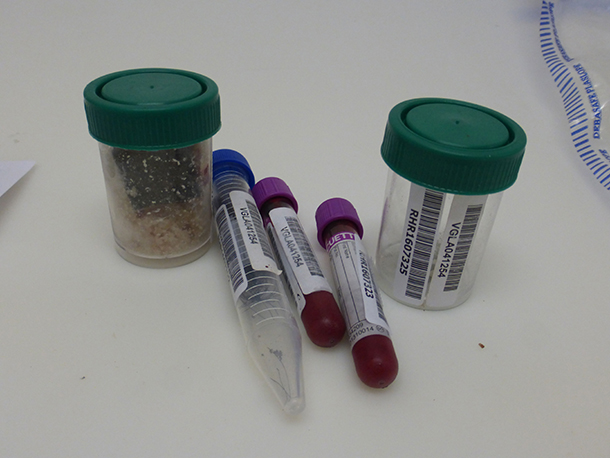
A rhino tissue sample kit (Photo: Bobby Bascomb)
RIOS: You need to have a number of concurrent processes going. You need to do the forensics but, even if you have that information, you need to have the criminal legislation in place, and you need to have investigators and prosecutors who know how to use the scientific evidence. You need to train along the entire chain of enforcement.
BASCOMB: The ultimate source of wildlife protection, the Convention on International Trade in Endangered Species, or CITES, recently met in South Africa. Rhinos have had the highest level of CITES protection since 1977 when trade was completely prohibited. This year the Kingdom of Swaziland petitioned to legalize the sale of humanely harvested horn. CITES delegates declined to pass the new rule, fearing that illegal horn from poached animals could be laundered in with the sustainably harvested horn. But Pelham Jones from the Private Rhino Owners Association says the rhino DNA data base would make that impossible.
JONES: Because every horn, before it enters the trade market, has to go through the process of verification of its DNA etc. so in simplistic terms, if you’re not a chicken farmer you cannot be bringing chicken to the market. So, can illegal horn enter the market on the South African side? We say, no, it cannot because of the traceability via DNA.
BASCOMB: DNA technology is also being used to create synthetic rhino horn. A biotech company in Seattle, Washington makes synthetic horn which they hope to sell at a lower price than real horn and put poachers out of business. But Cindy Harper from the DNA lab says the synthetic horn is virtually indistinguishable from the real horn, so she believes it’s a bad idea.
HARPER: The company that’s currently really at the top of the drive is wanting to put DNA into synthetic horn, that is something I simply don’t understand. I don’t see any other synthetic product, such as synthetic fur or meat or anything else, having the actual animal’s DNA put into it. The only reason I can think for doing that is to make it impossible for law enforcement to differentiate that.
BASCOMB: Harper says, law enforcement agents already have their work cut out for them. She estimates that just one percent of seized rhino horn samples actually come back to her lab to get matched up on the database.
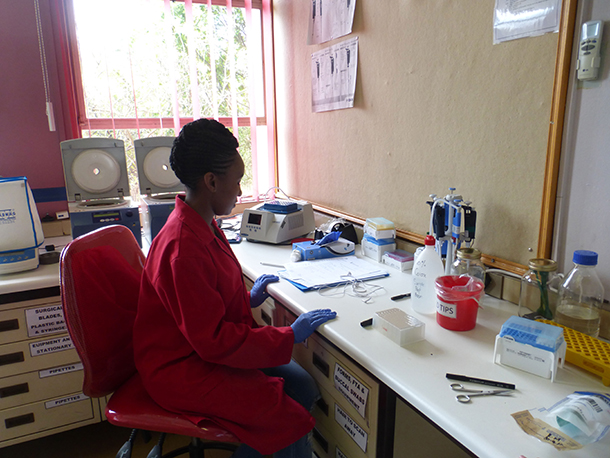
A lab tech processes a rhino DNA kit (Photo: Bobby Bascomb)
HARPER: That is the next step in the process. Making sure that we get these seized samples back and to be able to look at the whole movement of these horns globally. The criminals are organized. We need to make sure that everybody else who’s fighting those criminals are equally organized.
BASCOMB: Harper’s lab is working hard to register all of Africa’s rhinos, but there’s a long way to go, and it’s a race against time. More than 1,300 have already been killed so far this year.
For Living on Earth, I’m Bobby Bascomb in Pretoria, South Africa.
Related links:
- “South Africa deploys CSI-style tactics to crack rhino poaching rings”
- White rhinos are considered Near Threatened on the IUCN Red List
Mark Seth Lender: Giraffe Brotherly Love
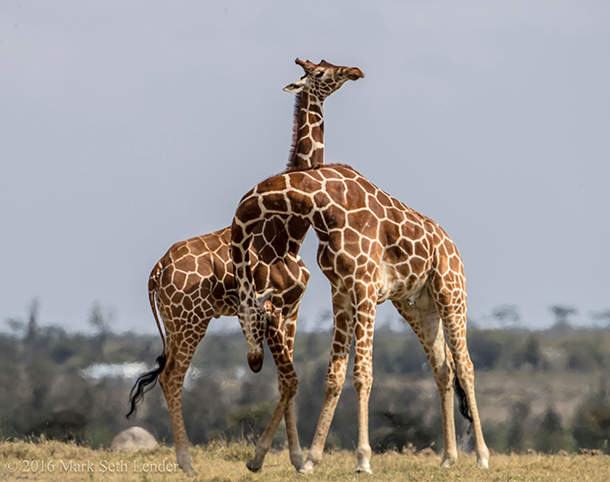
Giraffe often communicate through physical movements and interactions (Photo: Mark Seth Lender)
CURWOOD: We stay in Africa, with another iconic savannah species, the giraffe. At night, giraffe hum, a sound akin to a huge double bass. But they’re silent by day so when they communicate it’s mainly by visual or tactile cues. And in Kenya, at the equator, our resident explorer Mark Seth Lender eavesdropped on a pair of young giraffe having just that kind of conversation.
See One Do One Teach One
© 2016 Mark Seth Lender
All Rights Reserved
LENDER: In the only way they can, 5 giraffe are lying down: Necks towering, feet tucked under, like shallow-rooted trees. They have chosen this patch of grass that mounds up above the plain for the safety of the view. One by one they rise, long legs awkward in their unfolding, and in their stately upright way walk toward a stand of acacia where they will feed.
Some yards behind two remain. They are six months, maybe a year apart, giraffe at four fifths and two thirds scale. Elder Brother, and Little Man, and the eight hundred pounds between them.
Little Man presses his chest against his brother's flank and slowly rubs neck to neck, once, twice, and once again his horns coming to rest well below the other's chin. And in reply Elder swings the mallet of his head down, down on Little Man and once, twice, thumps him in the ribs
And so it begins.

A young reticulated giraffe sporting his spots (Photo: Mark Seth Lender)
Now, it's Little Man's turn. Five tries love taps none connecting. Then stops. And strooooookes, and rubs his cheek on Elder Brother's throat as if to say: “We're only kidding right?
Elder leans, and gently, rests his head on Little Man's, “Let’s go!”
Little Man licks his brother’s long tufted tail, the conversation continuing: “Then show me again.”
Elder Brother slams a horn into that tender place back of the forelimb.
Little Man bounces sidewise to the blow. And gives it a go: Hit front leg hit back leg; now this place, now that place...
And they turn, and turn, and round each other like a maypole, The Kettle Drum, and The Piccolo…
Little Man: Like a duster
Elder: Like a deadfall.
Like a near miss
Like a Stone wall
Like a backslap
Like a hardball
Like an Air Kiss
Like a closed fist
The flick of a wrist
Like splitting rails, an iron nail, sent home in One! Blow!
“This is what it feels like, Little Man. This is what it means, to Fight!”
An act of Generosity beyond the casual encounter that it seems: When Little Man is Big Man, will he remember, or forget, the Teacher Old Man used to be?
CURWOOD: For a video Mark took of this pair jousting, and more, head on over to our website, LOE.org.
Related links:
- More about Giraffes
- About giraffe conservation from the Wild Nature Institute
- An article from BioMed Central on the verbal communication (or lack thereof) of giraffe
- Mark Seth Lender’s field work was made possible by Donald Young Safaris
- Mark Seth Lender Website
[MUSIC: Johnny Clegg & Juluka, “Akanaki Nokunaka,” on Musa Ukungilandela, Rhythm Safari]
CURWOOD: Coming up...applying some principles developed by J. S. Bach to city planning. That’s just ahead here on Living on Earth. Stay tuned.
ANNOUNCER: Funding for Living on Earth comes from you our listeners, and United Technologies - combining passion for science with engineering to create solutions designed for sustainability in the aerospace, food refrigeration and building industries. UTC companies such as Otis, Carrier, Pratt & Whitney and UTC Aerospace Systems are helping to move the world forward.
This is PRI, Public Radio International.
[CUTAWAY MUSIC: Jacques Loussier Play Bach Trio, “Prelude and Fugue No.1 in C-Major, BWV 846 (Well-Tempered Clavier)” live at Jazzwoche Burghausen 2007, ]
The Well-Tempered City

A “well-tempered” city is one in which varying needs are met harmoniously, says Jonathan Rose. (Photo: AV Dezign, Flickr CC BY-NC-ND 2.0)
CURWOOD: It’s Living on Earth, I’m Steve Curwood.
[MUSIC: J.S.Bach: Oboe Concerto A major Recon from BWV49/169/1053. Allegro ma non tanto [Hammer/Rifkin] Pro arte digital [https://www.youtube.com/watch?v=UBoCR2eOOJ0&list=PLiJnN4bTWJ12aISIGJYe0m8IRkL8CacJD&index=6]
CURWOOD: Some music-lovers believe Johann Sebastian Bach created some of the most sublime works in the whole classical repertory. As a composer Bach changed and helped to define the whole language of Baroque music. He inspired many who came afterwards, and that includes urban visionary Jonathan Rose. In his latest book, "The Well-Tempered City: What Modern Science, Ancient Civilizations, and Human Nature Teach Us About the Future of Urban Life", he imagines the city as an ecological system, in need of harmony.
Jonathan Rose, welcome back to Living on Earth.
ROSE: Thank you so much. I'm happy to be here.
CURWOOD: Jonathan, the title of your book takes its cue from Bach's famous composition, "The Well-Tempered Clavier". Why did you pick this title?
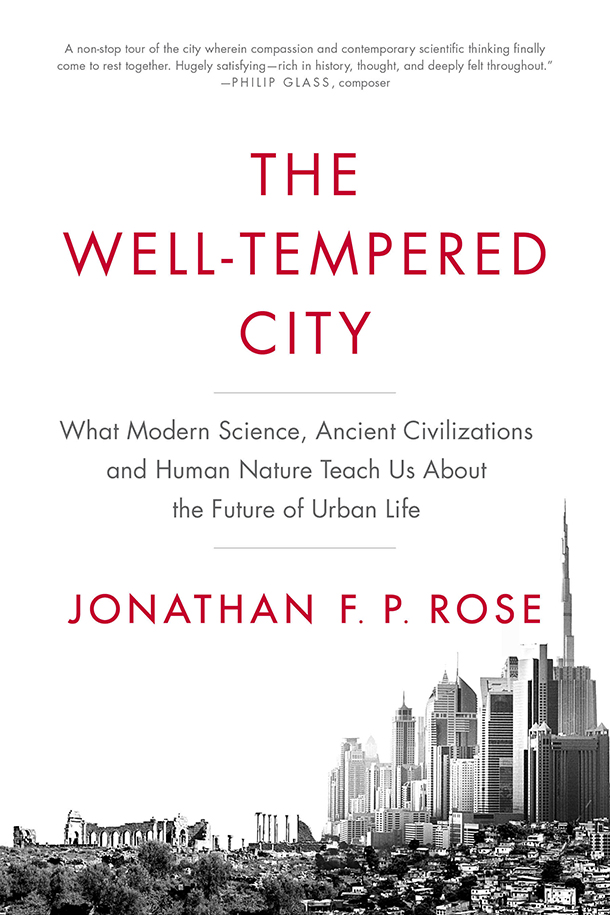
Jonathan Rose’s new book, The Well-Tempered City, is now available for readers to purchase. (Photo: Courtesy of Jonathan Rose Companies)
ROSE: Well, I picked it because I love Bach's music, and one of the amazing things that Bach did with his music was he tried to imagine the architecture of the universe, and bring it to life on Earth for all of us. It's an amazing aspiration, and I believe we actually with our cities need to have very high aspirations.
[MUSIC: https://www.youtube.com/watch?v=HlXDJhLeShg] Performer & Album Info - 1:52:15
Bach: The Well Tempered Clavier - Book 1 BWV 846b -- C Major – Fugue]
ROSE: There was another issue, and that's the actual idea of temperament itself. About 2,500 years ago, Pythagoras, an amazing Greek mathematician, Pythagoras observed that the distance between the notes on a lyre were exactly the same proportion as the distance between the spaces between the planets, and he said this was the golden proportion, that everything should be tuned exactly that way. For the next 2,500 years, everything was tuned exactly that way, and it worked really well when you were playing an individual instrument in an individual key, but it turns out that you couldn't go from key to key to key. And, for Bach to achieve his amazing goals, he actually needed an expanded range of music to deal with. By 1700, Bach was able to compose in what was called “temperment,” which is actually finding tuning to the spaces in between perfections. It's not exactly perfect, but it's good enough, and it really allowed for amazing music. It allowed him to unleash the entire range of the keyboard to express his music, and I feel that's something we need, is vast integration that we need to do with our cities also.
[MUSIC: https://www.youtube.com/watch?v=HlXDJhLeShg] Performer & Album Info - 1:52:15
Bach: The Well Tempered Clavier - Book 1 BWV 846b -- C Major – Fugue]
CURWOOD: In your book, you make a number of analogies between city systems and works by biologists. How can we think of urban spaces as ecological systems?
ROSE: There's an amazing biological idea called biocomplexity, and the core of the idea is that all of nature comes from a vast and integrated gene pool. So, for example, think about human beings. We breathe in oxygen. We breathe out carbon dioxide, and trees breathe out oxygen and breathe in carbon dioxide. We all fit together. Where did all this come from? It comes from the fact that we have this common DNA. You've probably heard that human beings share 50 percent of the same DNA as a banana does, and 96 percent of the DNA as a frog. These integrate us in an amazing tapestry of life. We do not have that same integration in our cities, but if you think of a city plan as the gene pool of a city, and we can figure out how to tie all the parts together so that they actually can co-evolve together. What nature has it is so magnificent, is an amazing adaptive capacity, and what human civilization needs, what our cities need is that same adaptive capacity.
CURWOOD: So, you want to bring all these things together, and in your book you write, “Imagine a city with Singapore's social housing, Finland's public education, Austin's smart grid, the biking culture of Copenhagen, the urban food production of Hanoi,” and I could go on because you go on to list another 20, 30 cities. So I gather what you're saying is that right now too many cities do things in silos, that they just focus on one aspect whether it's housing or education or transportation, and this all needs to somehow come together.
ROSE: So, actually I'm saying two different things. First of all, in that fantastic list that you read, the point is, there are amazing things happening in cities all over the world and even more interestingly, cities are consistently learning from each other which is also really, really good. And so when I propose this idea of a magnificent and ecologically sensitive city, and people say it's impossible, then I can point and say, "Look, but if you just did what they're doing in Copenhagen, which is really great, and you're doing with they're doing in San Francisco, which is really great, and you're doing what they're doing in Seattle, you put it all together you would have solved a lot of problems.” Your second point is absolutely true about silos, that we function too much in silos and what we're learning is...So for example, if you want to solve a key part of affordable housing, you need higher density to help pay for it, and if you have higher density and you put it next to mass transit then that helps solve traffic problems and allows more space for parks and nature. And so the pieces all fit together, so we have to get out of our silo-designing, individual solutions and see we need to design integrated solutions.

Rose’s Via Verde is a green, affordable and mixed-income housing building in the South Bronx. The multiple rooftops contain community gardens, playgrounds, amphitheaters, solar panels, an orchard and even an exercise room overlooking the city. (Photo: Courtesy of Jonathan Rose Companies)
CURWOOD: So, in your book you outline some of the ways that cities can be thought of as having metabolisms. So talk to me about what constitutes the metabolism of the city and how it can contribute to social and environmental prosperity.
ROSE: A metabolism is the flow of energy and material through a system - Actually I also think information through a system - and interestingly 98 percent of the things that enter a city leave it six months later as waste. And that doesn't work when you have a population of 10 billion people and a huge demand for resources. That's a very linear system. So think, for example, in New York City, water is collected from a reservoir far north of the city and comes through big pipes that runs through our toilets and showers, etc., and it gets flushed out and it goes out into the ocean ultimately, a one-way system. So, we need to start creating circular systems, which again is just the way nature works, nature recycles endlessly. So, I looked at cities all around the world and Windhoek which is the capital of Namibia, a desert city in southern Africa, in the 80s discovered that it was beginning to grow rapidly and was going to run out of water. It hired an engineer and it built the world's first system that took its waste water, cleaned it up and turned it into its drinking water again, recycled it.
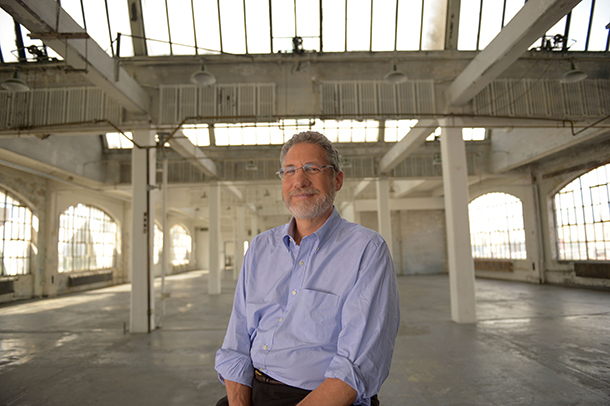
Jonathan F.P. Rose is a real estate developer who specializes in building affordable and mixed-income housing. (Photo: Courtesy of Jonathan Rose Companies)
The engineer who designed it said, “We should judge water by its quality, not by his history,” and that system's run for 40 years and never had a single accident. So in the cities, for example, in the American southwest, which are running out of water, beginning to do something like this. Now there’s a water treatment plant in the Washington, DC area that is taking the nitrogen and phosphorus, which are very polluting elements, out of the water for $100 a ton. They are selling it to fertilizer manufactures for $400 a ton, and so the waste treatment system is all of a sudden becoming a factory. They are capturing all of the methane that is coming out of the plant and using that to create energy, so all of a sudden it's become a energy generator, not only providing enough energy for itself but enough for the entire neighborhood around it. Now, imagine if we took these linear infrastructure systems and made them all circular systems. Imagine how many local jobs we could create, how much energy we could create, how many natural resources we could recycle.
CURWOOD: So, in your book you discuss the decline of the American cities in the 1970s. What was going on?
ROSE: A lot of factors were going on. First of all, jobs were moving out, first to the south. The great manufacturing union jobs which built so many middle-class lives were moving to the south and then abroad. The cities were incredibly polluted. There was not cohesive city planning. There was a lot of just disgruntlement and unrest, and the cities became more and more dangerous, and so people began to abandon and moved to the suburbs. And the more and more they moved to the suburbs, the more the cities, the very heart of them, began to hollow out, and they began to burn.
[MUSIC: Maurizio Pollini, The Well-Tempered Clavier Book 1 https://www.youtube.com/watch?v=8Ks9Q8AF4Do&list=RD8Ks9Q8AF4Do#t=924]
ROSE: So, what's happened is that cities are back. They are cauldrons of opportunity, They are places where people want to live. We have both young people who are coming to cities because they are bored in the suburbs and cities are where the education is, where the innovation is, where the cafés and jazz clubs and music and all that stuff. The life is in the cities and they want to be there. And, interestingly, the baby boomers are retiring and they no longer want to move to gated golf course communities, they actually want to move back to cities too for the same reasons that the young ones are moving but there's a second reason too. There's a lot of people retiring to live near their grandchildren.
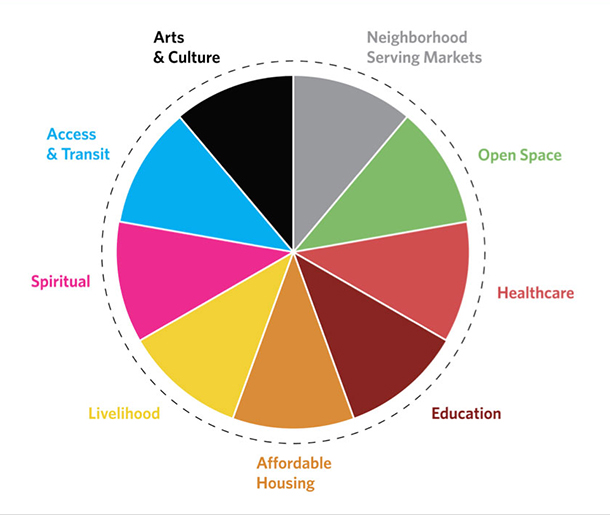
The infographic above shows the various pieces which make up a healthy, functional city and what Rose refers to as “communities of opportunity.” (Photo: Courtesy of Jonathan Rose Companies)
So there's a commencement of revitalization in cities and the issues is that's putting a great deal of demand on the housing stock, and there is not enough affordable housing for everybody who needs to live and work in cities. The answer is to create more affordable housing in cities, the only way to do that requires subsidy, and there are federal programs and there are state programs but those are not enough. Another tool cities are using to address the issue of affordable housing, what's called inclusionary zoning…They're saying if you can build market rates housing, a certain percentage of it has to be affordable and creates mixed income communities which are really healthier for people.
CURWOOD: You've, of course, done that sort of work yourself directly. We've talked in the past about your Via Verde community in the South Bronx, a place that a few years ago you mentioning that, hey, get a place in the South Bronx people would say, "What? You're nuts!", but I gather your facility is oversubscribed. What makes that place work?
ROSE: So, what make's that place work is, first of all, it's beautiful. It is extremely green. It has solar panels and great insulation, and cross ventilation. It's right near mass transit. It's right near a whole bunch of retailers, so it is walkable to many things. And then the green, it actually continues to the entire public realm so it has a children's playground on the entry level and then it has an amphitheater where all kinds of community events take place. It has an orchard that we're going to describe as going up to roofs. It then has an orchard. It has community gardens. It has on the seventh floor overlooking the whole city a fantastic exercise room, community room, so it’s really designed is an amazing place to live, and it is half affordable rental housing and half middle-income co-ops ownership housing. So it's a really wonderful integrated community.
[MUSIC: Maurizio Pollini, The Well-Tempered Clavier Book 1 https://www.youtube.com/watch?v=8Ks9Q8AF4Do&list=RD8Ks9Q8AF4Do#t=924]
CURWOOD: So talk to me now about the role that big data plays in making cities more efficient?
ROSE: Let's start first of all with defining what our objectives are because we're going to use big data then to make sure we're achieving our objectives. So, one of the things that is emerging is the idea of communities developing their own community health indicators. It's a list of all the things that matter to them. It can be early childhood reading rates and high school graduation rates and reducing certain climate impacts and reducing water consumption and increasing affordable housing, increasing mass transit, hundreds of items that can all be defined to reflect where a community's vision is of the truly sustainable and equitable place. Then, with big data we can measure to see where we actually are: how healthy are our families, how green are our communities, etc. And we can track this through information coming from the public health sector, coming from our cell phones coming from the internet, coming from devices all over the city, and we can see how well we were doing. We can then use the tools of city governments which are the regulations, such as building codes and zoning, investments to cities, make an infrastructure, incentives such as tax breaks. All the things that cities use, we can see, “Are we getting closer or further away from our goals?” We can keep measuring, we can keep creating a real feedback system that becomes co-evolutionary towards our objectives, just the way nature works.
CURWOOD: So you talk about the living in green spaces promotes health and well-being. How are cities trying to increase that green infrastructure?

The German musician Johann Sebastian Bach, was famous for composing in “well temperament,” the inspiration for the title of Jonathan Rose’s new book. (Photo: Wikimedia Commons, public domain)
ROSE: Cities actually have a lot of incentive to increase their green infrastructure. The city of Philadelphia, for example, was faced with a $10 billion mandate from the EPA to separate its water from its storm water systems, and they went back to the EPA said how about if we spend $1 billion on parks and open space, on incentivizing green roofs, and planting more street trees, and we're going to absorb the storm water before it actually goes into the sewer system, and it will save us a huge amount of money, and the EPA said, “yeah that's a great solution.” And here's what happens when you plant trees. Remember the climate is changing and it's going to get hotter. We now know that neighborhoods that have a lot of trees are 6 degrees cooler in the summer than the neighborhoods that aren't. Trees absorb pollution. Trees absorb storm water, saving cities costs and saving the outflow of polluted water into the oceans and rivers, and houses that are next to trees and streets with a lot of trees have actually higher real estate values which is good for the homeowners, but also means they pay higher taxes which is good for the city, and finally we know that when neighborhoods have a lot of trees actually the mental health of the residents is better than neighborhoods that don't have trees.
CURWOOD: So, Jonathan, what's the connection between affordable housing and community strength?
ROSE: Steve, that's a really important question. Over 20 million American families today spend more than 50 percent of their income on housing, and when you think about the additional amount of funds they have to spend on transportation getting to and from work and then childcare, it's impossible to think about how they can feed and clothe themselves, much less move forward with their lives. So, having a base of safe, green, well-located affordable housing is really critical for individual family advancement. And the goal of all this is to create what I call an "equal landscape of opportunity for all", which I really believe is the American promise. So, once you have safe, green, well-located affordable housing, you need fantastic school systems in which every child in a neighborhood as an equal chance to get ahead.
Going back to that list of cities you read in the beginning, Finland has the best school system in the world, the best school performance, and every child goes an equally good school whether they live in the wealthiest neighborhood, the poorest neighborhood, the most Finnish neighborhood or the most immigrant filled neighborhood. Every school is equal. We do not have that in the United States, and I believe that should be part of the American promise. Same thing with access to healthcare. Healthcare should be...the quality of healthcare should be equal to all. The quality of access to healthy food should be equal to all, which is one of the reasons why we are seeing this amazing community garden movement. We need access to parks and open space, we need access to multiple means of affordable transportation, we need access to arts and culture, access to great jobs, and the last thing which I think is really important is we need churches, synagogues, mosques, places of meditation, places of reflection. We live a very frantic, overstressed life these days, and we need places of retreat where we can sit back as individuals and as communities and think about our own higher purposes.
[MUSIC: Maurizio Pollini, The Well-Tempered Clavier Book 1 https://www.youtube.com/watch?v=8Ks9Q8AF4Do&list=RD8Ks9Q8AF4Do#t=924]
CURWOOD: Jonathan Rose's book is called "The Well-Tempered City: What Modern Science, Ancient Civilizations, and Human Nature Teach Us About the Future of Urban Life". Thanks, Johnathan.
ROSE: Steve, it's always great to be with you.
[MUSIC: Maurizio Pollini, The well-Tempered Clavier Book 1 https://www.youtube.com/watch?v=8Ks9Q8AF4Do&list=RD8Ks9Q8AF4Do#t=924]
Related links:
- Living on Earth’s first story on Via Verde
- Jonathan Rose Companies’ website
- Harpsichord recording of Bach’s Well-Tempered Clavier (Book 1)
- Hammond and Rifkin recording of Bach’s Oboe Concerto in A major)
- Piano recording by Maurizio Pollini of the Well-Tempered Clavier (Book 1)
CURWOOD: Living on Earth is produced by the World Media Foundation. Our crew includes Naomi Arenberg, Bobby Bascomb, Aidan Connelly, Savannah Christiansen, Jenni Doering, Jaime Kaiser, Don Lyman, Alex Metzger, Helen Palmer, Adelaide Chen, Jennifer Marquis and Jolanda Omari. Special thanks this week to Donald Young Safaris. Tom Tiger engineered our show, with help from John Jessoe, Jeff Wade, Jake Rego and Noel Flatt. Alison Lirish Dean composed our themes. You can find us anytime at LOE.org, and like us, please, on our Facebook page - PRI’s Living on Earth. And we tweet from @LivingonEarth. I'm Steve Curwood. Thanks for listening.
ANNOUNCER1: Funding for Living on Earth comes you, our listeners, and from the University of Massachusetts, Boston, in association with its School for the Environment, developing the next generation of environmental leaders. And from the Grantham Foundation for the protection of the environment, supporting strategic communications and collaboration in solving the world’s most pressing environmental problems. Support also comes from the Energy Foundation, serving the public interest by helping to build a strong, clean, energy economy, from Gilman Ordway, and from SolarCity, America’s solar power provider. SolarCity is dedicated to revolutionizing the way energy is delivered by giving customers a renewable alternative to fossil fuels. Information at 888-997-1703. That’s 888-997-1703.
ANNOUNCER2: PRI. Public Radio International.
Living on Earth wants to hear from you!
Living on Earth
62 Calef Highway, Suite 212
Lee, NH 03861
Telephone: 617-287-4121
E-mail: comments@loe.org
Newsletter [Click here]
Donate to Living on Earth!
Living on Earth is an independent media program and relies entirely on contributions from listeners and institutions supporting public service. Please donate now to preserve an independent environmental voice.
NewsletterLiving on Earth offers a weekly delivery of the show's rundown to your mailbox. Sign up for our newsletter today!
 Sailors For The Sea: Be the change you want to sea.
Sailors For The Sea: Be the change you want to sea.
 The Grantham Foundation for the Protection of the Environment: Committed to protecting and improving the health of the global environment.
The Grantham Foundation for the Protection of the Environment: Committed to protecting and improving the health of the global environment.
 Contribute to Living on Earth and receive, as our gift to you, an archival print of one of Mark Seth Lender's extraordinary wildlife photographs. Follow the link to see Mark's current collection of photographs.
Contribute to Living on Earth and receive, as our gift to you, an archival print of one of Mark Seth Lender's extraordinary wildlife photographs. Follow the link to see Mark's current collection of photographs.
 Buy a signed copy of Mark Seth Lender's book Smeagull the Seagull & support Living on Earth
Buy a signed copy of Mark Seth Lender's book Smeagull the Seagull & support Living on Earth

